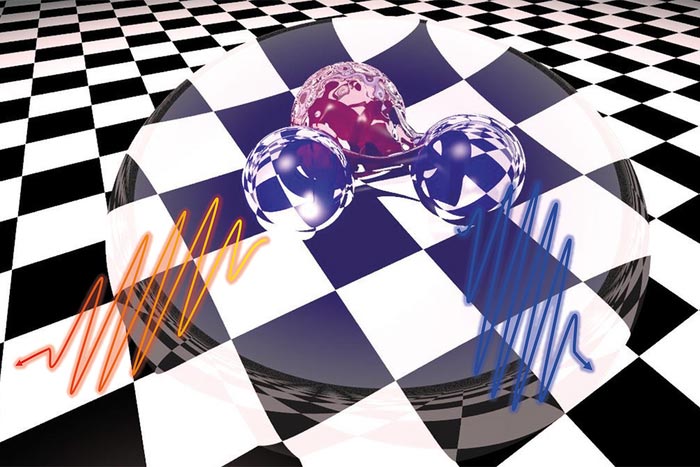A seemingly unattainable energy transition

Researchers have stimulated a seemingly unattainable energy transitionInside inside a quantum dot, i.e. a tiny structure within a semiconductor.
Credit: RUB, Arne Ludwig
Researchers from Basel and Bochum have succeeded in addressing an apparently unattainable energy transition in an artificial atom using laser light. Making use of the so-called radiative Auger process, they were the first team to specifically excite it. In this process, an electron falls from a higher to a lower energy level and, as a result, emits its energy partly in the form of light and partly by transferring it to another electron. The artificial atoms are narrowly defined areas in semiconductors that could one day form the basis for quantum communication. The findings are described by the team from the University of Basel and Ruhr-Universität Bochum together with colleagues from Münster and Wroclaw in “Nature Communications”, published online on 12 November 2021.
Electrons move between energy states
Atoms consist of a nucleus and electrons that travel around the nucleus. These electrons can assume different energy levels. Electrons that are more tightly bound to the nucleus, i.e. closer to it, have a lower energy than electrons that are further away from the nucleus. However, the electrons can’t assume any arbitrary energy levels – only certain levels are possible.
If an electron acquires energy, for example by absorbing a light particle, i.e. photon, it can be raised to a higher energy level. If an electron falls to a lower energy level, energy is released. This energy can be emitted in the form of a photon. But it can also be transferred to one of the other electrons; in this case, only some of the energy is released as light, the rest is absorbed by the other electron. This process is known as the radiative Auger process.
Exciting a unique energy transition with two lasers
By irradiating light particles, electrons can not only be lifted to a higher energy level; they can also be stimulated to give off energy by an incident light particle. The energy of the incident light particle must always correspond exactly to the difference in the two energy levels between which the electron is to be transferred. The researchers have used two lasers: one moved electrons between a low and a high energy level; the other between the high and a medium energy level. This middle energy level corresponds to a non-equilibrium level: the transfer to the middle level doesn’t exist without a radiative Auger process. In addition, a transition between the low and the medium energy level shouldn’t have occurred, because the relevant light was not irradiated. However, precisely this seemingly impossible transition occurred in reality due to the energy transfer from one electron to another in the radiative Auger process.
The ultrapure semiconductor samples for the experiment were produced by Dr. Julian Ritzmann at Ruhr-Universität Bochum under the supervision of Dr. Arne Ludwig at the Chair for Applied Solid State Physics headed by Professor Andreas Wieck. The measurements were carried out by a team from the University of Basel run by Clemens Spinnler, Liang Zhai, Giang Nguyen and Dr. Matthias Löbl in the group headed by Professor Richard Warburton.
Journal: Nature Communications
DOI: 10.1038/s41467-021-26875-8
Article Title: Optically driving the radiative Auger transition
All latest news from the category: Physics and Astronomy
This area deals with the fundamental laws and building blocks of nature and how they interact, the properties and the behavior of matter, and research into space and time and their structures.
innovations-report provides in-depth reports and articles on subjects such as astrophysics, laser technologies, nuclear, quantum, particle and solid-state physics, nanotechnologies, planetary research and findings (Mars, Venus) and developments related to the Hubble Telescope.
Newest articles

Innovative 3D printed scaffolds offer new hope for bone healing
Researchers at the Institute for Bioengineering of Catalonia have developed novel 3D printed PLA-CaP scaffolds that promote blood vessel formation, ensuring better healing and regeneration of bone tissue. Bone is…

The surprising role of gut infection in Alzheimer’s disease
ASU- and Banner Alzheimer’s Institute-led study implicates link between a common virus and the disease, which travels from the gut to the brain and may be a target for antiviral…

Molecular gardening: New enzymes discovered for protein modification pruning
How deubiquitinases USP53 and USP54 cleave long polyubiquitin chains and how the former is linked to liver disease in children. Deubiquitinases (DUBs) are enzymes used by cells to trim protein…


